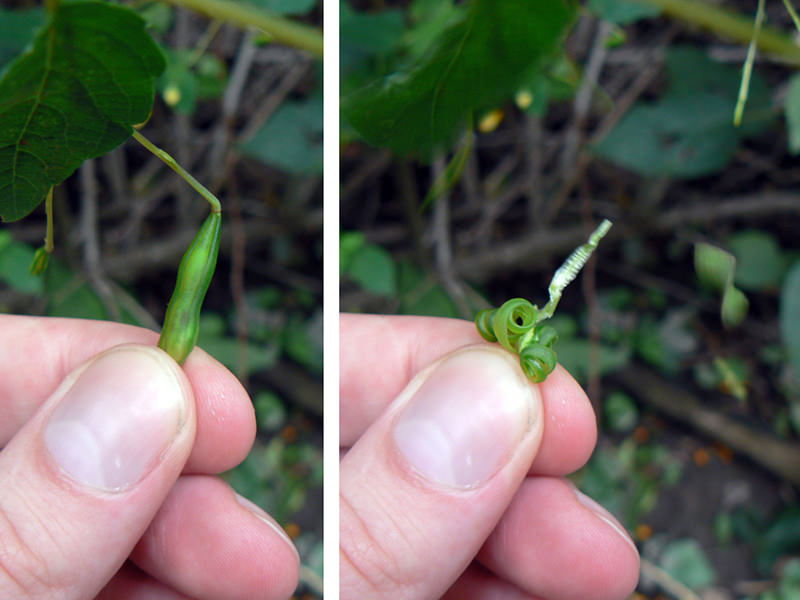


Anna Hesser/Flickr
My favorite plant this time of year is jewelweed, aka touch-me-not. It’s been blooming in our area during July and August and has now developed the pod for which its second common name is given. I’ve been watching with child-like impatience for my favorite nature game to begin. In your part of the country you may find an orange-blooming species called Impatiens capensis or a yellow-blooming variety called Impatiens pallida. Both grow in damp soils in part shade to full sun.
The correct term for the method that these plants use to spread their seeds is “ballistic.” The name alone gives you a good idea of what is going to happen here. The pod that appears in mid- to late-August plumps and turns a bit yellow when it is ready to pop. By lightly placing your fingers on either side, the heat from your touch will cause an explosion. The pod itself is actually made up of five valves fused together. When stimulated, they twist away from one another, violently flinging the seeds inside.
I struggle to leave enough pods to share with my kids and students. You will often find me crouched along my front walkway giggling insanely as I incite this plant to spread its next generation throughout my shade garden.
Soothing To The Skin

Benny Mazur/Flickr
There’s so much more to talk about with jewelweed than its ability to jump away from you. It’s a really important plant to know for all manner of skin irritation. I would say it is second only to chickweed (Stellaria media), only because it’s so juicy that it can be difficult to preserve. Some freeze a tea of fresh plants that has been reduced. Some make ointments and soaps. It seems that an alcohol tincture is not a successful method of preservation because it’s difficult to keep the high water content from encouraging mold in the final product.
My favorite way to use this plant is just after I’ve tangled with poison ivy. It’s action is in preventing the oils of the poison ivy plant from binding with your skin. While it won’t heal a rash, it will prevent the oils from spreading to cause a rash in the first place. I simply walk over to where I have allowed jewelweed to volunteer, and break off a stalk. In just a minute of crushing and rubbing the plant between my hands I have a moist and thick liquid that can be washed all over any suspected contact areas. This type of preparation is called a succus and can also be created by putting the plant in the blender. A jewelweed soap or liniment would also work, and these can be convenient things to carry with you while hiking.
Jewelweed is also helpful for nettle stings, bug bites and general itching. It’s anti-inflammatory and mildly anti-fungal. An ointment of the plant has been used successfully to relieve the swelling and pain of hemorrhoids and the intense itching of athlete’s foot.
If you think you don’t know jewelweed, you may be surprised that you’re most likely very well acquainted with a close relative. The impatiens flower that is common in landscaping is part of the jewelweed family. It is said that the landscape variety has some of the same medicinal qualities, but I think that’s probably a bit of a stretch. For me, I’ll keep my volunteer jewelweeds in a section of the front garden and leave the impatiens at the garden center. My weeds attract the ruby-throated hummingbird. All season long, these plants tickle me to no end. Do you have some in your garden?




